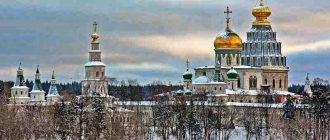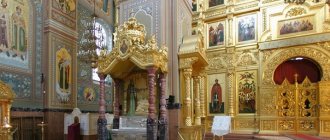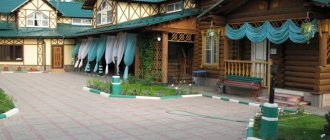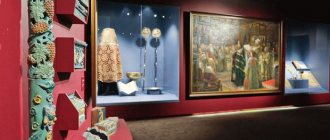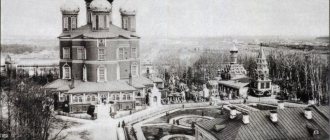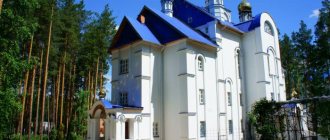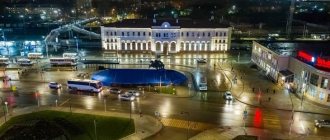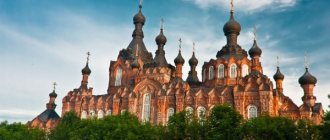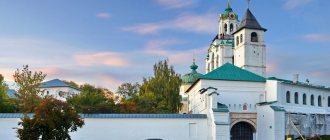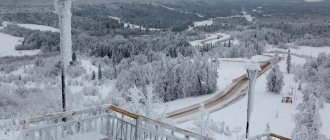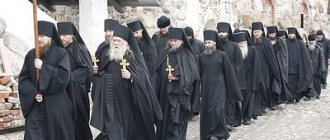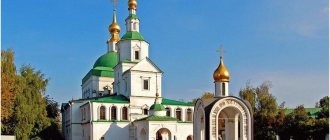This Saturday, my friends and I decided to leave Moscow for a one-day trip to Istra, walk around the area, and visit the New Jerusalem Monastery, which many have heard about, but few have visited. It was also interesting to see the museum of wooden architecture. The summer of 2014 turned out to be cold and rainy, but this did not stop us from traveling.
Istra. New Jerusalem
New Jerusalem 2022: review of a trip to the monastery after restoration
On Saturday, despite the preparations the day before and the intention to leave at 9 am, we all overslept and got into the car only at 12. We started the navigator on our smartphone (it was enough to enter the official address of the monastery in Istra, Sovetskaya Street, 2) , he led us along the Novorizhskoe highway. You can get to Istra along the Volokolamsk highway, but there was a big traffic jam there. The journey by car took us about an hour, despite the fact that the distance from Moscow is small - only 60 km.
We arrived at the main entrance to the Monastery around 15-00. I must say that if you arrive here late, you won’t have time to see anything; the ticket office and main places to visit are open only until 16-30. The entrance to the territory of the New Jerusalem Monastery is open until 18-00.
There is free parking for cars in front of the monastery entrance. We were lucky - a place became available right before our arrival.
New Jerusalem. Square in front of the monastery
On the square in front of the monastery there was a brisk trade in all kinds of souvenirs, beggars hung out, but they were afraid to approach us on our hike.
New Jerusalem Monastery: schedule of services, address and how to get there
There are many of us like-minded people and we are growing quickly, we post prayers, sayings of saints, prayer requests, and timely post useful information about holidays and Orthodox events. Subscribe. Guardian Angel to you!
The Resurrection New Jerusalem Monastery is one of the most revered and popular communities located in the central part of the Russian state, and its distinctive feature is that the Resurrection Church located here was built in the likeness and image of the Cathedral of the Holy Sepulcher on Calvary (Jerusalem). However, in appearance, these two communities are completely different from each other. But you can find out how to get to the monastery, the schedule of services, what shrines there are and much more from this article.
History of the creation of the temple
The cathedral is also commonly called the New Jerusalem. Patriarch Nikon decided to recreate Palestinian shrines in the Moscow region, so that this, in turn, would allow the Russian people to see the sacred places of Christ’s Resurrection.
In 1685, the construction of the Church of Constantine and Helen, as well as the Resurrection Cathedral, was completed, but the creation of the gate temple of the Entrance of the Most High and the fortress wall were completed in 1697, but already under Peter I.
However, at this stage the construction work was not completed, since, not having stood for 30 years, the stone tent of the Church of the Resurrection collapsed. Work on its restoration lasted right up to 1761, during the end of the reign of Empress Elizabeth.
Icons and shrines of the New Jerusalem Monastery
In the community itself, Orthodox Christians can see such shrines as:
- sample of the Cathedral of the Holy Sepulcher (collapsible) - this model was imported to Moscow in 1649 and was used by Patr. Nikon during the construction of the monastery;
- The tabernacle from the chapel of Equal-to-the-Apostles St. Mary Magdalene is a divine vessel in which the Blood and Body of Christ is stored;
- The 17th century antimension is a board that depicts the placement in the tomb of the Almighty;
- A recent acquisition was an icon donated to the New Jerusalem Monastery by the President, which depicts the Most High Lord on the Throne (dating from the 18th century).
Shrines
The main cathedral of the monastery contains a fragment of the liturgical vestments of Patriarch Nikon and a model of the Jerusalem Temple, which was taken as the basis for the construction of the Cathedral of the Resurrection of the Lord.
Figure 5. Model of the Jerusalem Temple
The Resurrection New Jerusalem Monastery houses the relics of the Holy Great Martyr Tatiana. You can also pray in front of the reliquary here. Particles of the Life-giving Cross of the Lord and the holy relics of the Apostle Mark, who is the author of one of the Gospels, are sewn into it.
Schedule of services
Services are held in the men's monastery according to the following schedule:
Monday. Fifth Week of Great Abstinence. St. Benedict of Nursia:
- How did you go? - 10 points! Via Yandex.Traffic.
When this answer became a common phrase, I realized it was time to change something. You can’t get around the whole world on foot, but finding parking for a helicopter would be problematic. Then the imagination helpfully drew endless rails, like dreams of travel, converging beyond the horizon, a cozy carriage with flashing landscapes outside the window and the opportunity to leave traffic jams in the past.
To New Jerusalem by train
In addition, a successful offer came up from the “Central PPK” to go on a tour by train to visit the Resurrection New Jerusalem Monastery, the museum complex “New Jerusalem” and listen to the concert of the “Moscow Virtuosi”.
To New Jerusalem by train
The royal journey in the footsteps of Patriarch Nikon
In April 1903, a groaning train delivered Emperor Nicholas II and his wife Alexandra Feodorovna to the Resurrection New Jerusalem Monastery to celebrate Easter. The royal couple arrived at the New Jerusalem railway station, opened in 1897. In 1901, a new platform was built, calling it “Istra”. The railway route shortened the travel time by 3-4 times; before this, pilgrims used the Nikolaevskaya road, which led to the Kryukovo station, where they had to change to a carriage and shake over bumpy bumps, admiring the scenery. Currently, a commuter train covers the distance from Moscow to Istra in 1 hour and 15 minutes. By paying 308 rubles for a round-trip ticket, you can relax and immerse yourself in history.
To New Jerusalem by train
The future Patriarch Nikon was born in 1605 in Mordovia. In the world his name was Nikita. His mother died early, and his father married someone else, who became an evil stepmother for the little boy. A difficult childhood, frequent beatings and hunger forced Nikita to run away from home more than once. He sought protection, shelter and consolation within the monastery walls. At the insistence of his parents, Nikita got married, but soon decided to take monastic vows. From that moment on, Nikon’s brilliant “career” began, and after some time a rapprochement with Tsar Alexei Mikhailovich began. In 1652, Nikon was enthroned as the Patriarchs of Moscow and All-Russia. At the same time, he managed to obtain the king’s promise not to interfere in the affairs of the Church. The era of reforms and changes has begun. Nikon sought to bring Russian Orthodox rites into line with Greek ones, including, he prescribed baptism with three fingers. All this led to a split in the Church into supporters of Nikon (“Nikonians”) and Old Believers.
Resurrection New Jerusalem Monastery
The Resurrection New Jerusalem Stavropegic Monastery was founded by Nikon in 1656. The Patriarch understood that it was almost impossible for ordinary people to get to the Holy Land, so he decided to bring the Orthodox shrine closer - the Church of the Holy Sepulchre. The stone Cathedral of the Resurrection of Christ was laid in 1658; Patriarch Nikon worked on it for 8 years. But due to disagreements with the tsar, in 1666 Nikon was deprived of his patriarchal rank and sent into exile. Work on the temple was suspended and resumed only after some time.
Resurrection New Jerusalem Monastery
In 1681, Nikon was allowed to return to the New Jerusalem Monastery, but he died on the way. The Patriarch was buried in the Resurrection Cathedral.
Nikon's burial place
During the Soviet period, the monastery was closed, its property was nationalized. But the monastery suffered the most in 1941. The Germans set up a headquarters and a hospital on its territory; during their retreat, they blew up the cathedral and fortress walls. But the oldest part of the temple and the shrine have been preserved. The walls were less fortunate, but they were restored during Soviet times. The latest restoration lasted from 2008 to 2016. During this time, much was revived, recreated and rebuilt. The grandiose Resurrection Cathedral greets all visitors to the monastery. It consists of three parts: the underground temple, the Church of the Holy Sepulcher and the Rotunda Church.
Resurrection Cathedral
Multi-colored tiles were used to decorate it. Craftsmen from different cities of Russia were invited to make them. You can get acquainted with the production technique and see the original tiles in the ceramics museum, located in the Malt Chambers on the territory of the monastery.
Museum of Ceramics
Currently, the cathedral is partially decorated with old tiles, and partially with new samples created using ancient technology.
Tiles in the Cathedral
You should definitely walk along the fortress wall to admire the territory of the monastery and the temple from all sides.
The monastery is active; 15 monks live within its walls.
Tour of the New Jerusalem Monastery
If you stand facing the monastery, then on your left hand there will be a small building with a sign “Excursion Bureau”. Having checked whether there were any available guides, we decided to book an individual excursion (cost 1,500 when viewing the full exhibition, 900 rubles when viewing only the territory of the monastery and the Ascension Cathedral). Entrance to the territory of the monastery itself is free. A fee is charged only for the ability to walk on the walls when they are open. In our case, the passage was closed due to restoration.
In addition to ordering excursions, here you could purchase tickets to visit the museum of wooden architecture, which is located behind the monastery. More precisely, visiting the territory itself is free, you only pay for the entrance directly to the Hut, where items of peasant everyday life are presented (50 rubles for entry, 150 rubles for photography). We still bought the ticket, although even in advance it was clear that there was a catch here.
Here at the tour desk we studied a map of the monastery and the area around it.
So, after 5 minutes our guide came out and led us to the territory of the Resurrection New Jerusalem Stauropigeal Monastery.
Entering the gate, we froze at the view of the main cathedral of the monastery - the Resurrection Cathedral and the bell tower. The spectacle was truly stunning: the gilded domes sparkled majestically against the background of a stormy sky.
Resurrection Cathedral
Here the guide began her story.
New Jerusalem Museum
The museum's exhibition is based on original monastic artifacts, including religious objects, utensils, documents and icons; the museum collection numbers over 180 thousand items. In 2014, the museum moved to a new building and received a modern, interactive look. The permanent exhibition tells about New Jerusalem as a historical, cultural and architectural monument of Russia, allows you to better learn about the stages of construction of the monastery, get acquainted with the craftsmen who worked on its creation, see ancient icons, original documents and get more information about Patriarch Nikon.
New Jerusalem Museum
New Jerusalem Museum The
museum also hosts exhibitions of famous artists, for example, in October of this year the works of Robert Falk were presented.
The concert program deserves special attention. In October 2018, “Moscow Virtuosi” performed for the first time on the stage of the New Jerusalem Museum.
Address of the New Jerusalem Museum: Istra, Novo-Ierusalimskaya embankment, 1, https://njerusalem.ru
The organization of tours by train is carried out by JSC "Central PPK".
Replica of the Jerusalem Chapel
The idea and basis for the construction of the monastery complex was the model of a real existing temple, which the Patriarch of Jerusalem Paisius gave to Nikon in 1649. The model was made of wood. It is still kept in the New Jerusalem Museum. The institution is located next to the monastery. Also used during construction were engravings of drawings made from drawings by the Italian traveler Bernardino Amico, and the memoirs of the Russian believer monk Arseny - “Proskinitarium”.
The chapel includes 2 parts:
- The western building, in which a copy of the Holy Sepulcher is preserved. This structure is 2.07 meters long and 1.93 meters wide. The shape is a 6-gon;
- The eastern building is 3.9 meters long and 3.4 meters wide with an Angel's chapel and a piece of stone that was removed by an angel for Jesus to exit the cave.
Exactly in the middle of the chapel there is a pedestal with part of the above-mentioned stone. Entrance to both buildings is open to everyone during times when the Divine Liturgy is not held.
How to get to the New Jerusalem Monastery
- By train - from Rizhsky station, Kursky station or from Tushino station (nearby is the metro station of the same name). The fare from the Tushino station is less than from the train stations, but in the summer season the trains can be overcrowded due to summer residents. Go to the Istra or Novoierusalimskaya stations. Then walk for about 20 minutes (2 km), you can also get to the monastery by bus, go to the “Monastery” stop
- By bus - from the Tushino metro station to the city of Istra, bus number 372 runs, go to the Pochta stop, the travel time will be about an hour.
Description
From a bird's eye view, the New Jerusalem Monastery looks like a well-fortified fortress rising on a hill, in the central part of which the golden-domed Resurrection Cathedral is located. Its tent-shaped dome with 60 windows can be called the hallmark of the monastery.
In the Resurrection Cathedral, as in the Church of the Holy Sepulcher in Jerusalem, there are three main shrines of Christians:
- Golgotha is a small rock where Christ was crucified (translated from Greek the word “Golgotha” means place of execution)
- Edicule - a small chapel with the Holy Sepulcher, the burial place of Christ
- Church of the Resurrection of the Savior, the place of the life-giving Resurrection of Jesus Christ.
Golgotha, the site of the crucifixion of Christ, is located on the second tier of the temple; a staircase leads to it, located to the right of the main entrance. In a small room there is a cross made in Jerusalem and matching in size to the Jerusalem Cross of the Lord. There is also a stone with a crack installed here, imitating the rock that split at the moment of the Savior’s death, when the blood of Christ was spilled on it.
On the western side of the temple there is a rotunda with a huge two-tier dome attached, in the center of which there is a cuvuklia, that is, a chapel with the Holy Sepulcher. Here is the bed on which the body of Christ was placed in a cave on the slope of Mount Golgotha.
In the temple, next to the entrance, there is the Stone of Anointing, onto which the Savior’s body was transferred when taken down from the cross; here it was anointed with myrrh (fragrant oil) and prepared for burial.
In the New Jerusalem Monastery, as in Jerusalem, the entrance to the temple is located on the south side. In the eastern part there is an underground church of Saints Constantine and Helena, located at a depth of six meters. A legend has been preserved that it was at this depth that Queen Helen found the Life-Giving Cross. The Israeli Temple of Constantine and Helena is carved into the rock.
In addition, on the territory of the New Jerusalem Monastery there are temples built at the end of the 17th century:
- Refectory Church of the Nativity of Christ - in the western part of the monastery
- Entrance to Jerusalem Gate Church, located above the eastern Holy Gate.
The shape of the monastery’s territory resembles a hexagon, enclosed by a fortress wall three meters wide. The length of the fence is about 1000 meters, and the height is 9 meters. 8 towers of artistic significance were built in the corners and breaks; their names coincide with the names of the towers of the old city of Jerusalem.
The necropolis of the temple is located near the Church of Constantine and Helena, as well as inside the cathedral, where many respected people are buried, including the founder of the monastery, Patriarch Nikon.
The domes of the cathedral rise above the chapels located behind the main altar. In three chapels you can see iconostases created under Patriarch Nikon.
Underground part of the complex
The underground Church of Constantine and Helen is located at the eastern wall of the Resurrection Cathedral. The chapel is connected to the main building by an underground passage. It was built on the model of a similar temple that exists in Jerusalem. Only on holy ground it is carved into the rock, and not dug into the ground.
The church is buried 6 meters into the ground. It rises only 1.5 meters above the ground. The chapel was built in 1658 and was originally a simple rectangular building with one dome decorated with tiles. In the middle of the 18th century, during the renovation of the entire complex of the New Jerusalem Cathedral, stucco was added to its decoration. Now the building has 5 chapters. Only one of them is decorated with a cross.
The entrance to the church is made of massive wooden doors. There are 33 steps leading from the Resurrection Cathedral to the temple, which symbolize 33 years of the life of Jesus Christ. The gallery that leads to the chapel is very wide. More than 10 people can walk up the stairs at the same time. The external entrance to the church, as of October 2022, is being restored. The exact date of its opening is unknown. The temple building is surrounded by a moat with a special pipe for draining water. The walls of the recess are lined with stone. The moat is surrounded on top by a fence made of limestone blocks.
Inside the church there is a unique three-tiered iconostasis forged from copper. Also in the building are the graves of the wife and son of the outstanding Russian commander Alexander Vasilyevich Suvorov. The Generalissimo's wife donated a lot to the New Jerusalem Monastery and for this reason was given the honor of being buried in the monastery. You can recognize places of eternal rest by special slabs with funeral inscriptions.
Resurrection Cathedral
From the history
In the middle of the 17th century, Patriarch Nikon of Rus' and Tsar Alexei Mikhailovich decided to build a monastery on the Istra River, similar to the one located in the Holy Land in Jerusalem. At that time, the Ottoman Empire dominated the land of Palestine and visiting Jerusalem by Christians was associated with danger.
The lands on the banks of the Istra were perfectly suited for the construction of an analogue of Golgotha: the role of the Jordan River was played by the Istra, the hill in the east of the territory resembled the Mount of Olives, and the hill in the northwest resembled Mount Tabor, the park next to the monastery could become an analogue of the area of Gethsemane - the garden the foot of the Mount of Olives.
In 1649, the Patriarch of Jerusalem Pasius brought to Moscow a model of the Church of the Holy Sepulcher, in accordance with which the construction of the Ascension Monastery began, which became an analogue of the Jerusalem Golgotha.
Construction took place in two stages: initially, in 1658 - 1666, the temple was built to the roof, a place was dug for the underground church of Constantine and Helena, and a bell tower was erected. 15 bells were cast for it, one of them has survived to this day. Platbands and ceramic belts were used for decoration, and iconostases were installed.
After Nikon's conflict with the Tsar, the Patriarch fell into disgrace, and at the end of 1666, by decision of the Moscow Council, he was deprived of his clergy, he became a simple monk and was exiled to the Ferapontov Monastery.
Nikon never saw the monastery he founded, dying in 1681. And the construction of the New Jerusalem Monastery was completed by its abbot, Archimandrite Nikonor.
Construction of the cathedral resumed only in 1679: a dome was erected over the central part of the temple, a tent with a diameter of 22 meters was installed over the rotunda for the Holy Sepulcher, and the underground church of Constantine and Helen, consecrated in 1690, was completed.
Despite the fact that the plan of the built cathedral is a copy of the Church of the Holy Sepulcher, its decoration and design were made using elements of ancient Russian art.
The cathedral resembles a Russian tower, decorated on the outside with platbands and cornices, friezes and balustrades. The most beautiful pattern - the peacock eye - decorated many of the tiles used. This famous design resembles a pomegranate flower, which resembles the eyes on a peacock's tail.
The inside of the temple is decorated with carvings and stucco, made in the Baroque style.
Under Soviet rule, in 1919 the monastery was closed and a museum was located on its territory.
In December 1941, German troops occupied Istra and occupied New Jerusalem. Before leaving, the Germans destroyed the cathedral - the central chapter, bell tower and rotunda dome were blown up.
The restoration of the monastery began already in 1942, but only in 1985 was the central chapter restored, and in 1993 - the dome of the rotunda. And just recently, in 2014, the bell tower was recreated. Currently, with the support of the state, work is underway to restore the interior and exterior decor, as well as other monastery buildings.
In 1995, the monastery was transferred to the Russian Orthodox Church and currently on its territory there is the New Jerusalem Monastery and one of the largest museums in the Moscow region - the New Jerusalem Historical, Architectural and Art Museum.
Resurrection Cathedral
The Resurrection Cathedral is a building that completely replicates the Church of the Holy Sepulcher. It belongs to the Byzantine type buildings - with four large pillars and a gilded dome. The latter is located above the altar and has 12 tiers. There are many windows on the inner sides of the dome walls. Belts with icons are inserted between them. When the light passes through the window openings of the tent, it seems that the entire monastery soars into the sky and wants to rise as high as possible.
The interior decoration of the chapel amazes pilgrims with its splendor. The cathedral has a huge 12-tier iconostasis 24 meters high. It is decorated with gilding. The icons that are inserted into the building depict the Virgin Mary with little Jesus, the 12 apostles and the most revered saints. Near the iconostasis there are two vestibules: one is green for the patriarch, the second is red for the king.
Resurrection Cathedral
The main holy place of the Resurrection Cathedral is the cuvuklia - an exact copy of the burial and resurrection site of Jesus Christ. It was built exactly under the main dome of the chapel, opposite the altar. After the fire of 1802 in Jerusalem, when the original edicule burned down, it was on the model of the monastic monument that a new edicule was made in Palestine. Also under the dome, on the wall hangs a stucco coat of arms of the Russian Orthodox Church with the crown of the patriarch, which is made of white clay.
During the construction of the cathedral, the original design, taken from a wooden model of the Church of the Holy Sepulcher, was reworked in the Baroque style. Characteristic elements of this style appeared on the building: a pile of volumes that gradually decreased, narrow and high windows decorated with ornaments, and a lot of stucco molding decorating the exterior and interior of the temple.
Resurrection Cathedral
On the eastern side, the chapel is connected to the underground temple of Constantine and Helen, the base of which is located at a depth of 6 meters. To the south of the temple there is a high bell tower, which has 7 tiers and a top in the form of an onion dome.
The Resurrection Cathedral is the main building of the New Jerusalem Monastery. Its domes are clearly visible from anywhere in the city of Istra and neighboring villages. On weekdays, services are held in the temple at 8:00. On weekends and holidays, liturgies begin at 7:00.
New Jerusalem in the Moscow region
Not far from Moscow there is an unusually beautiful place - the Resurrection New Jerusalem Monastery, popularly called New Jerusalem. The idea to recreate Palestinian shrines in Rus' belongs to Patriarch Nikon. This made it possible for the Russian people to see the places of the saving passion and the Resurrection of Christ; it was difficult and unsafe to get there during the Ottoman Empire.
The monk Arseny Sukhanov was sent to Palestine, who drew up drawings of the structures on the spot. The scale of the buildings was slightly reduced compared to the real ones, so that the monastery was only an image of the Holy Land.
During the construction of the monastery in the second half of the 17th century, the nearby lands became part of it and received names taken from the gospel texts: Zion, Bethany, Tabor, Olivet, the Garden of Gethsemane, the Kidron Stream and the Jordan River.
The layout of the main building in the center of the monastery - the Resurrection Cathedral - corresponds to the Church of the Holy Sepulcher in Jerusalem. But the cathedral itself does not look like the Jerusalem temple; Patriarch Nikon himself personally designed the appearance and interior decoration of the cathedral. The Patriarch personally supervised the construction for several years, but the Patriarch was not able to see the monastery in all its glory. Only during the reign of Empress Elizabeth Petrovna was the New Jerusalem Monastery completed.
Inside you can see the dungeon where Christ awaited execution, and the Edicule - a marble chapel in the center of the temple, hiding the Holy Sepulcher. Next to the Holy Sepulchre, thirteen silver lamps belonging to the Orthodox Patriarchate, thirteen to the Catholic Patriarchate, thirteen to the Armenian and four to the Coptic are usually lit.
In the mid-18th century, the Resurrection Cathedral was restored. The famous architect Bartolomeo Rastrelli supervised the construction work; according to his design, a tent with sixty windows cut into it was built.
The Church of the Entry of the Lord with the Holy Gates, built at the end of the 17th century, is part of the monastery wall. The church is a multi-tiered temple.
In 1941, the monastery was captured by German soldiers, where they set up a hospital. During their retreat, the Resurrection Cathedral was blown up. Since 1959, restoration work has been carried out on the territory of the monastery. In 2016, it is planned to completely restore the monastery complex.
Recovery
The restoration of the temple began already in 1942. Then the buildings of the complex were examined by architects from the workshop of Alexei Shchusev. At the same time, drawings were created for the restoration of the cathedral. But real work began only in 1950. From 1957 to 1984 they continued with maximum intensity. After the collapse of the USSR, in 1994 the entire complex of the New Jerusalem Monastery was transferred to the Orthodox Church. From that time on, divine services began to be held in the monastery.
In 2008, Russian President Dmitry Medvedev visited the cathedral. After this, on March 6, 2009, he signed a decree on taking measures to completely restore the chapel. On May 8, 2016, the temple was consecrated by Patriarch Kirill. Now, in October 2022, the final finishing work is continuing in the cathedral. Their completion is planned for 2022. But the temple already rises above Mount Zion in all its glory.
How to get to the New Jerusalem Monastery
By train
Option 1.
From Rizhsky railway station or from the stations “Tushino” (metro station “Tushinskaya”), “Leningradskaya” (metro station “Voikovskaya”), “Dmitrovskaya” (metro station “Dmitrovskaya”), trains depart to
the station “ Novoierusalimskaya”
. Trains are approaching, whose terminal stations are Novoierusalimskaya, Rumyantsevo, Volokolamsk, Shakhovskaya.
At the Novoierusalimskaya station, go along the underground passage towards the station building. There is an underground passage nearby to the other side of Panfilov Street. After crossing, go further along Panfilov Street, without turning anywhere. The Jerusalem shopping center can serve as a reference point. Crossing the Istra (Jordan) river over the bridge, you can admire the view of the monastery. Travel time is 20 minutes.
Option 2.
Take the train to the Novoierusalimskaya station or the Istra station and take a minibus to the Monastyr stop or ask the driver to stop closer to the monastery gate.
By bus
From the Tushinskaya metro station, take bus No. 372 to the Pochta stop in the city of Istra. Then transfer to a bus or minibus to the Monastyr stop.
